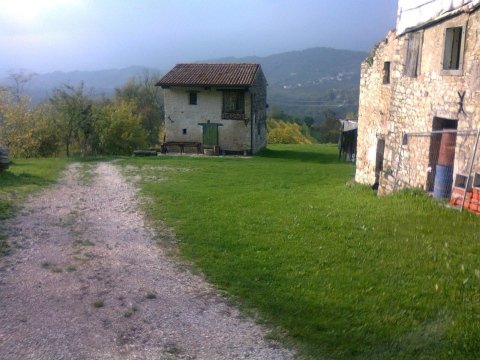

Il territorio e la sua storia
L’azienda ricade nel perimetro del Prosecco Conegliano Valdobbiadene DOCG. E’un territorio a volte aspro, a volte dolce e con dominanze tali da rendere i percorsi militari degli antichi romani molto più sicuri dei percorsi di valle.
Sembra che proprio da Borgo Schiavin passasse l’antica strada romana Claudia Augusta Altinate che partiva da Altinum, la 'Venezia Romana', la più importante città a vocazione soprattutto militare della Decima Regione Romana , centro di smistamento del grande porto mercantile sull'Adriatico e porta verso i confini nord-orientali dell'impero.
Conduceva in Rezia, la regione centrale dell'area germanica danubiana e bavarese.
E' così chiamata in ricordo dell'imperatore Claudio che, attorno al 46 d.C., potenziò la traccia segnata dalle campagne alpine e contro i Reti, attorno al 15 a.C., dal padre Druso, facendone un vero e proprio sistema infrastrutturale militare.
Lungo tutto il tragitto vennero edificati castelli, torri, ponti e città, che sopravissero alla caduta dell'impero e furono, sia pure a tratti isolati, infrastrutture vitali dell'economia medioevale.
Va sottolineato il fatto che la strada di epoca romano-imperiale denominata "via Claudia Augusta", per gran parte del suo tragitto, ricalca più antichi tratturi e vie di comunicazione esistenti fin dal Neolitico pastorale e artigianal-commerciale dei Palafitari, in parte già in uso nel Mesolitico se non addirittura nei preistorici percorsi dell'Epigravettiano nel Paleolitico Superiore.
Sospetto che la piccola stalla da me restaurata fosse in realtà una antica torre romana di avvistamento, data la dominanza e le fondamenta realizzate con massi ciclopici, propri di una torre (di cui propongo l’immagine), poi adattata a stalla per le vacche e/o costruita sulle probabili rovine.

The company falls within the perimeter of Prosecco Conegliano Valdobbiadene DOCG. It is a territory that is sometimes harsh, sometimes sweet and with dominances that make the military routes of the ancient Romans much safer than the valley routes.
It seems that the ancient Roman road Claudia Augusta Altinate passed from Borgo Schiavin, which started from Altinum, the 'Venice Romana', the most important city with a mainly military vocation of the Tenth Roman Region, the hub of the great merchant port on the Adriatic and door to the northeastern borders of the empire.
It led to Rezia, the central region of the Danubian and Bavarian Germanic area.
It is named in memory of the emperor Claudius who, around 46 AD, strengthened the track marked by the Alpine countryside and against the Reti, around 15 BC, by his father Drusus, making it a real military infrastructure system.
Along the way, castles, towers, bridges and cities were built, which survived the fall of the empire and were vital infrastructures of the medieval economy, albeit at times isolated.
It should be emphasized that the Roman-imperial road called "via Claudia Augusta", for most of its journey, follows the oldest sheep tracks and communication routes existing since the pastoral and artisanal-commercial Neolithic of the Palafitari, in part already in use in the Mesolithic if not even in the prehistoric paths of the Epigravettian in the Upper Paleolithic.
I suspect that the small stable I restored was actually an ancient Roman watchtower, given the dominance and foundations made with cyclopean boulders, typical of a tower (of which I propose the image), then adapted to a stable for cows and / or built on probable ruins.

Il Borgo
A fianco della stalletta fu eretto il Borgo Schiavin, baricentrico all’interno della proprietà, che ha rappresentato un forte elemento di antropizzazione. Dopo secoli di storia fu abbandonato e da lì comincia la nostra. E la nostra volontà è quella di fare di tutto per riportarlo all’antico splendore, recuperando il possibile e utilizzando materiali antichi e/o del posto. E’ per questo che è nato lo Spumate Fato 1734 che speriamo ci consentirà di acquisire le risorse per iniziare il delicato restauro. Tutti quelli che lo degusteranno saranno sostenitori e fautori di questo recupero , che ringraziamo e invitiamo . Fato 1734 è una risorsa anch’essa scoperta in azienda, in quanto è una scritta scolpita su uno stipite da chi partecipò allora alla sua posa. Grazie di cuore. Francesco e Rossella Borghi

The Borgo Schiavin was built next to the stable, a center of gravity within the property, which represented a strong element of anthropization.
After centuries of history it was abandoned and our history begins from there.
And our will is to do everything to restore it to its ancient splendor, recovering what is possible and using ancient and / or local materials.
This is why Spumate Fato 1734 was born, which we hope will allow us to acquire the resources to begin the delicate restoration. All those who taste it will be supporters and supporters of this recovery, which we thank and invite.
Fato 1734 is also a resource discovered in the company, as it is an inscription carved on a jamb by those who then participated in its installation.
Thank you so much.
Francesco and Rossella Borghi

![]()
AZIENDA AGRICOLA BORGO SCHIAVIN PROSECCO FATO 1734 | Località: Mondragon Di Arfanta - Arfanta - 31020 Tarzo (TV) - Italia |
P.I. 02003040264 | Cell. +39 348 7846979 | info@proseccofato1734.com